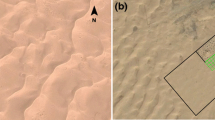Abstract
The wind fetch effect is important to wind erosion and aeolian transport and controls aeolian flux. It is useful to study the wind fetch effect in determining the aeolian transport mechanism and improving our knowledge of aeolian physics and wind erosion. In this paper, multichannel samplers measure aeolian transport at different heights above an artificial Gobi surface in the southeastern region of the Tengger Desert. The results show that aeolian transport flux can be expressed as an exponential function of height. Wind fetch obviously affects aeolian flux and aeolian transport. The coefficients and relative decay rate of aeolian flux decrease and then increase with increasing wind fetch distance. Aeolian transport depends on the height and fetch distance; aeolian transport increases and then decreases with increasing fetch distance, reaching a maximum at a fetch distance of about 34 m at the very near surface. The fetch distance of maximum aeolian transport tends to increase with height.
Similar content being viewed by others
References
Gillette D A, Herbert G, Stockton, et al. Causes of the fetch effect in wind erosion. Earth Surf Proc Land, 1996, 21: 641–659
Bauer B O, Davidson-Arnott R G D, Hesp P A. Aeolian sediment transport on a beach: Surface moisture, wind fetch, and mean transport. Geomorphology, 2009, 105: 106–116
Dong Z B, Wang H T, Liu X P, et al. The blown sand flux over a sandy surface: A wind tunnel investigation on the fetch effect. Geomorphology, 2004, 57: 117–127
Bauer B O, Davidson-Arnott R G D. A general framework for modeling sediment supply to coastal dunes including wind angle, beach geometry, and fetch effects. Geomorphology, 2002, 49: 89–108
Davidson-Arnott R G D, Yang Y Q, Ollerhead J, et al. The effects of surface moisture on aeolian sediment transport threshold and mass flux on a beach. Earth Surf Proc Land, 2008, 33: 55–74
Stout J E. Wind erosion within a simple field. T Am Soc Agr Eng, 1990, 33: 1597–1600
Delgado-Fernandez I. A review of the application of the fetch effect to modelling sand supply to coastal foredunes. Aeolian Res, 2010, doi: 10.1016/j.aeolia.2010.04.001
Jackson D W T, Cooper J A G. Beach fetch distance and aeolian sediment transport. Sedimentology, 1999, 46: 517–522
Li Z S, Zhang Q F. Evolution of streamwise sand transport with distance (in Chinese). J Desert Res, 2006, 26: 189–193
Qu J J, Huang N, Ta W Q, et al. Structure characteristics of Gobi sand-drift and its significance (in Chinese). Adv Earth Sci, 2005, 20: 19–23
Fryear D W, Saleh A. Wind erosion: Field length. Soil Sc, 1996, 161: 398–404
Williams G. Some aspects of the eolian saltation load. Sedimentology, 1964, 3: 257–287
Fryrear D W, Saleh A. Field wind erosion: Vertical distribution. Soil Sc, 1993, 155: 294–300
Dong Z B, Qian G Q, Luo W Y, et al. Analysis of the mass flux profiles of an aeolian saltating cloud. J Geophy Res, 2006, 111: D16111
Kind R J. One-dimensional aeolian suspension above beds of loose particles—A new concentration profile equation. Atmos Environ, 1992, 26: 927–931
Gillies J A, Berkofsky L. Eolian Suspension above the saltation layer, the concentration profile. J Sediment Res, 2004, 74: 176–183
Nickling W G. Eolian sediment transport during dust storms: Slims River Valley, Yukon Territory. Canadian. J Earth Sci, 1978, 15: 1069–1084
Shao Y P, Leslie L M. Wind erosion prediction over the Australian continent. J Geophy Res, 1997, 102: 30091–30105
Juan E P, Buschiazzo D E, Zobeck T M. Comparison of different mass transport calculation methods for wind erosion quantification purposes. Earth Surf Proc Land, 2010, 35: 1548–1555
Nordstrom K F, Jackson N L. Effect of source width and tidal elevation changes on aeolian transport on an estuarine beach. Sedimentology, 1992, 39: 769–778
Van der Wal D. Effects of fetch and surface texture on aeolian sand transport on two nourished beaches. J Arid Environ, 1998, 39: 533–547
Lynch K, Jackson D W T, Cooper J A G. Aeolian fetch distance and secondary airflow effects: The influence of micro-scale variables on meso-scale foredune development. Earth Surf Proc Land, 2008, 33: 991–1005
Davidson-Arnott R G D, Dawson J C. Moisture and fetch effects on rates of aeolian sediment transport, Skallingen, Denmark. Proceedings Canadian Coastal Conference. Canadian Coastal Science and Engineering Association, Ottawa, Canada, 2001. 309–321
Farrell E J, Sherman D J. Process-scaling issues for aeolian transport modeling in field and wind tunnel experiments: Roughness length and mass flux distributions. J Coastal Res, 2006, 39: 384–389
Author information
Authors and Affiliations
Corresponding author
Rights and permissions
About this article
Cite this article
Zhang, Z., Dong, Z. & Zhao, A. Observations of Gobi aeolian transport and wind fetch effect. Sci. China Earth Sci. 55, 1323–1328 (2012). https://doi.org/10.1007/s11430-011-4326-7
Received:
Accepted:
Published:
Issue Date:
DOI: https://doi.org/10.1007/s11430-011-4326-7




